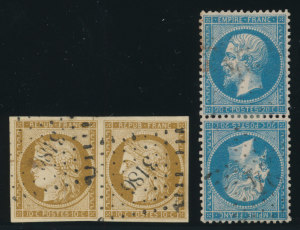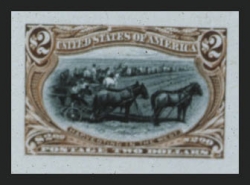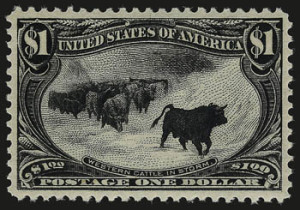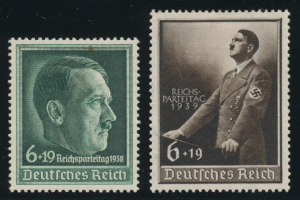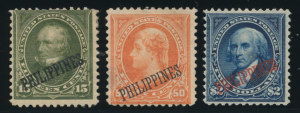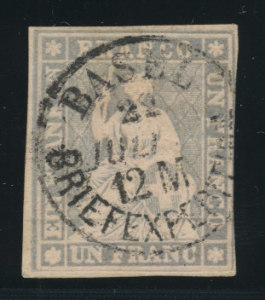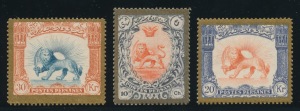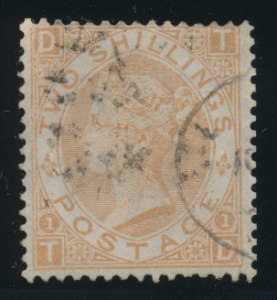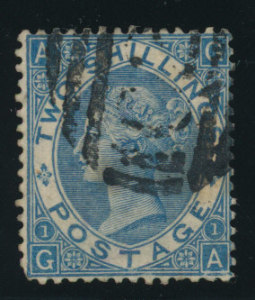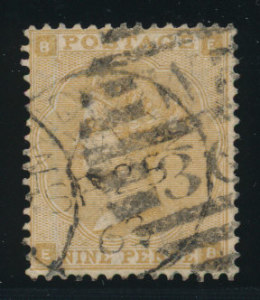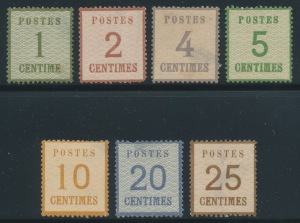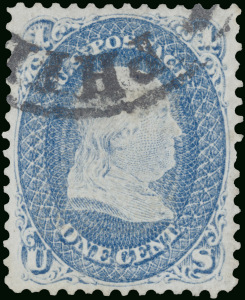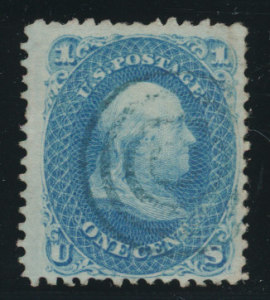Monthly Archives: July 2013
- Posted July 31, 2013Read more »France came a bit late to stamps, perhaps because issuing stamps for the prepayment of postage was not a Gallic idea, and so the French were resistant. Still, it was nearly ten years after the success of the Penny Black and the benefits that prepayment of postage conferred before France issued her first stamps in 1849. She was the last major country to do so. French philately has always been among the most popular in the world, and it was the French that even gave the name, philately, to our hobby. Early French dealers and collectors defined how we collect, and French influence on such aspects of our hobby as perforation measurement and shades are felt even today.French philately
- Posted July 29, 2013Read more »The 1898 Trans Mississippi appeared to be a commemorative set issued to honor America's expansion into the west. But its issuance served another purpose. It was hard to see at first why the 1898 Trans Mississippi set was made. The 1893 Columbian Exposition issue was widely criticized as being redundant in design and appearance and having too many high values, and it had been scorned by collectors. By 1898, higher dollar values of the Columbians were selling only fractionally above their face value, and this was only because the stamps could be used on controlled mail, and, when soaked off by the recipients, the used stamps could be sold to collectors for a significant percentage of the mint price, thus giving these higher values a sort of double duty. Without this, it is unlikely that defective dollar value Columbians would have sold above face value for as long as fifteen years after they were issued. So by 1898, it was clear that stamp collectors certainly weren't clamoring for another
- Posted July 26, 2013Read more »There are three factors that make a fine philatelist and a fine stamp collection. They are the same factors that the first collectors dealt with, and the Modern period has allowed collectors to face these issues in a new way. The first factor is access to material. From the first, philatelic material was widely diffused. Collectors in one country in 1890 had a hard enough time finding material from their own nation, let alone stamps and covers from different countries. From the first, collectors and dealers maintained extensive international communication to obtain the material that they needed. Many serious philatelists planned their vacations around visits to philatelic hubs, and most of the finest collections from even as late as twenty years ago were made by people whose travels landed them in smaller stamp shops around the world. A client of ours, now in his nineties, once confided that the best part of his international engineering job was that his constant worldwide
- Posted July 24, 2013Read more »Some countries are so vast philatelically that collectors break them down into more bite sized units. Some philatelists try to collect all of the German area, but with over a million collectible varieties by the Michel catalog, the latest Lighthouse specialty albums for this country runs to over 25 volumes and has a retail value for the albums alone of over $5,000 (a price for albums that is more than the value of most collections that are in them). So collectors have divided Germany and Area into several main categories
- Posted July 22, 2013
- Posted July 19, 2013Read more »In many ways, Swiss philately tells the story of Central European stamp collecting since 1970. Switzerland was one of the first stamp issuers, and, like the Postmaster Provisionals of the United states, the first stamps of Switzerland were issued by cities and states, rather than by the Federal Swiss government. Collectors esteemed Swiss stamps from the beginning, and the classic issues are among the most sought after stamps.The collecting of Switzerland has changed dramatically in the last thirty years, and this reflects what has happened to classic philately in general. Fewer collectors today go in for highly specialized country collecting. As listed by the specialized Zumstein catalog, Switzerland can be collected by paper type, and a nearly endless range of perforation varieties are present in the late nineteenth century issues. There are fluorescent stamps in the twentieth century and coils
- Posted July 17, 2013Read more »Iran is not just a political pariah; it is a philatelic one as well. From an interest point of view, the stamps of Iran should be popular. The first issues, called the Lions (after the Shah's royal seal) are interesting with many rarer shades and varieties and types. And the post-1930 issues are well designed with an exotic flavor that should appeal to philatelists worldwide. There are many long definitive sets with rare high values. The country has oil wealth, and its national income should be increasing. The people of Iran are increasingly well educated and should begin to fit the collecting demographic that has propelled the stamps of China, India, and Russia. And there is a wealthy, educated, and successful Iranian expatriate community, another good indicator of philatelic popularity.Iranian philately suffers from two main problems. The first is the problems caused by Iran's political stances. Iran
- Posted July 15, 2013Read more »
William O Bilden passed away recently at the age of 94. I came across news of his death the same hour that I saw an old Philatelic Foundation Certificate with the name of Harry Keefer on it. Bill and Harry were two prominent dealers of the 1950's and 1960's who were part of new wave of post WW II collectors and dealers who radically changed the ways of philately.
Until the end of WW II, stamp collecting was all about stamps. There were people who collected covers, but there were very few cover collectors who did not also collect stamps as their primary interest and then added cover collecting as an additional interest. Except for such items as Civil War Patriotics and Pony Express covers, where the cover itself is the story, most pre war cover collecting was about the stamp first. Collectors enhanced their stamp collections by trying to add covers to them. This began to change about 1945 when a new generation began to emphasize cover collecting in new ways. - Posted July 12, 2013Read more »Philately has gone through three main phases as far as non-auction acquisition of stamps is concerned. Beginning about 1880, stamp shops began to crop up in major cities. By 1935, the height of philatelic retailing was reached with Manhattan alone having over a hundred retail stamp shops. Cities like Philadelphia boasted over twenty, and in larger cities the presence of stamp shops wasn't limited to the center, more heavily trafficked part of town, but extended to the neighborhoods as well. With so many shops, a stamp Saturday was a real treat for collectors. They would go from store to store looking for what they needed and could often do a considerable amount of comparison shopping in an afternoon. By the mid-1950s, stamp shops began to close in many cities. By 1960, Philadelphia was down to six main shops, and by 1970, three. Increases in central location rents is often given as the reason for the decline in stamp shops in the post-WWII period. I've looked at retail
- Posted July 10, 2013Read more »Now it doesn't matter much because high technology printing can pretty much do anything in a jiffy, but in the nineteenth century, it would have been much cheaper if all stamps had been printed in one color. The reason that they weren't was because different letters to different places in differing weights required different postage. This meant that post offices issued stamps with different denominations. The reason that these different denominations were printed in different colors was so that the postal clerks could distinguish the different denominations when they used them. If all stamps were printed in the same color, regardless of denomination, it would have been much more difficult to determine if the correct postage had been paid.In general, when a stamp was issued the color remained the same, except for minor shade variations, throughout the issuing period. Most stamps are either rare or common
- Posted July 08, 2013Read more »Great thematic stamp collections help the viewer understand history in new ways. Recently, a collection came our way that underscores this. The collector, a historian, had a thesis that modern history is viewed through too narrow a lens. He took a long view of European history. The Hundred Years' War, for instance, was never called that by the five generations of men and women who fought and suffered through them. They saw the conflict, fought between 1337 and 1453, as a series of related struggles, but the significance of what this series of conflicts accomplished was not apparent until centuries later.Our historian philatelist took the long view towards his thematic collection: "The War for European Unity." He has seen modern history as the growth of independent nation states and the gradual unification of the traditional independent state through economic cooperation and trade which has rendered traditional
- Posted July 03, 2013Read more »The latest monthly edition of the American Philatelist, the magazine of the American Philatelic Society, shows that after the last round of dues that the society membership has slipped to about 32000. When I first started in this hobby the APS had over 60000 members.In 1975 membership in the American Philatelic Society was required if you wanted to be involved in buying and selling stamps as a dealer or serious collector. Most stamp auction houses used APS membership as their primary reference source-if you were an APS member your bids were accepted, if you weren't, things were far more difficult. The magazine the American Philatelist was the finest in this country (though the Collector's Club Philatelist was more erudite) and was worth the price of membership by itself. Thousands of members belonged for the sales circuits where
- Posted July 01, 2013Read more »$100 or $1,000,000?
The reuse of postage stamps was an obsession of postal officials in the mid-nineteenth century. It was the reason that cancellations were used on letters. Still, postal officials in most countries thought this was not enough. They imagined a world of people soaking used postage stamps off envelopes, washing the cancellations either with ink eradicator or with boiling water, and reusing the stamps to defraud the post office of revenue. It was a reasonable fear. A 90

